Sydney Airport Bundle
How Does Sydney Airport Fly High in Sales and Marketing?
Sydney Airport isn't just a gateway; it's a destination, evolving from a transit hub to a premier retail and leisure experience. With a staggering 41.4 million passengers in 2024, the airport's commercial success is undeniable, contributing billions to the Australian economy. Discover how Sydney Airport's Sydney Airport SWOT Analysis reveals the strategies behind its remarkable transformation.
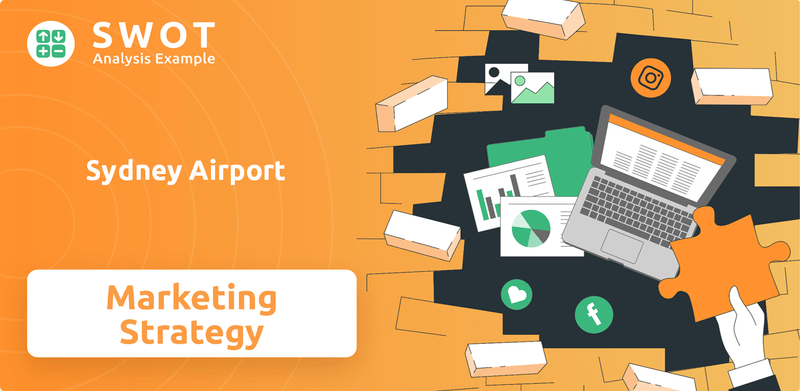
This analysis delves into the core of Sydney Airport's commercial strategy, exploring its innovative Sydney Airport sales strategy and dynamic Sydney Airport marketing strategy. We'll dissect its market analysis, examining how it drives passenger growth and maximizes revenue through strategic initiatives. Further investigation will uncover the secrets behind its brand positioning strategy, advertising campaigns, and digital marketing strategy, revealing how Sydney Airport attracts passengers and fosters customer relationships in a competitive landscape.
How Does Sydney Airport Reach Its Customers?
The sales and marketing strategy of Sydney Airport, a crucial component of its overall commercial strategy, involves a multi-faceted approach to generate revenue and enhance passenger experience. This strategy is designed to cater to diverse customer segments, encompassing airlines, retailers, service providers, and passengers. The airport's success hinges on effectively managing its sales channels to maximize revenue streams, attract passengers, and foster strong relationships with stakeholders.
Sydney Airport's commercial strategy is built on a foundation of direct and indirect sales channels. Direct engagement with airlines is a cornerstone of its aeronautical services, while a multi-channel approach is adopted for non-aeronautical revenue, particularly retail and services. The airport's focus on enhancing the passenger experience and leveraging digital technologies highlights its commitment to adapting to evolving market dynamics and consumer preferences.
The airport's sales channels are strategically designed to drive revenue and enhance the overall customer experience, reflecting a dynamic approach to market analysis and stakeholder engagement. This includes digital strategies, partnerships, and physical retail experiences.
The primary sales channel for aeronautical services involves direct engagement with airlines. This includes major carriers like Qantas, Virgin Australia, Jetstar, and Rex Airlines. The aviation partnerships team works closely with airlines to discuss business objectives, route development, and destination strategies.
Non-aeronautical revenue relies on a multi-channel approach. This includes physical retail locations within terminals, offering a world-class shopping experience. Digital strategies, such as engagement on Chinese social media platforms like WeChat, are also utilized. Partnerships, such as the media partnership with JCDecaux, are key.
Physical retail locations are a significant channel, with a focus on creating a world-class shopping experience. In 2023, the airport housed 20 international luxury brands. Lagardère AWPL was awarded a contract in 2024 to redefine the news, books, and convenience model. The airport's strategy also involves partnerships in the hospitality sector, such as the rebranding of Holiday Inn Sydney Airport to Crowne Plaza Sydney Airport in September 2024.
Digital adoption is crucial, with exploration of new strategies, including WeChat for the Chinese market. The extended media partnership with JCDecaux until 2029 is designed to connect brands with the airport's audience. This partnership, starting July 1, 2024, will significantly upgrade the media estate. This highlights the importance of digital marketing strategy for Growth Strategy of Sydney Airport.
The evolution of these sales channels reflects a strategic shift towards enhancing the passenger experience and maximizing revenue. The redevelopment of the luxury retail precinct, initiated in 2019, demonstrates a move beyond traditional airport retail to a more curated, high-value offering. The digital journey for customers and leveraging technology for seamless travel experiences suggests an integrated omnichannel approach for various services like parking and information.
Sydney Airport's sales strategy focuses on direct engagement with airlines for aeronautical services and a multi-channel approach for non-aeronautical revenue. This involves physical retail, digital platforms, and strategic partnerships. The airport aims to enhance passenger experience and maximize revenue through these channels, adapting to market changes.
- Direct airline partnerships to discuss business objectives.
- Physical retail locations with luxury brands and convenience stores.
- Digital marketing, including social media engagement.
- Media partnerships to connect brands with the audience.
Sydney Airport SWOT Analysis
- Complete SWOT Breakdown
- Fully Customizable
- Editable in Excel & Word
- Professional Formatting
- Investor-Ready Format
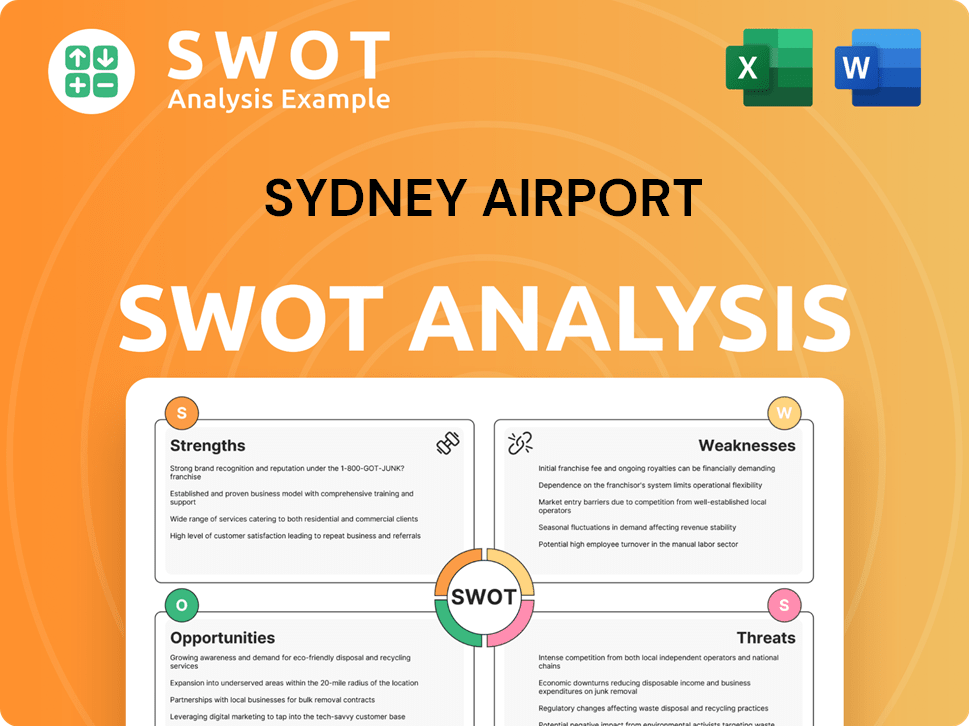
What Marketing Tactics Does Sydney Airport Use?
The marketing tactics employed by Sydney Airport are multifaceted, encompassing both digital and traditional strategies to enhance brand awareness, generate leads, and boost sales across its diverse offerings. A significant emphasis is placed on data-driven marketing and customer segmentation to tailor offerings effectively. This approach is crucial for understanding passenger behavior and preferences, enabling the airport to make informed decisions and personalize offerings.
Sydney Airport's strategy is deeply rooted in understanding its customers. The airport's commitment to understanding passenger behavior has continued, with a customer-centric segmentation refresh involving over 20,000 travelers, providing insights into evolving preferences and behaviors. This customer-centric approach allows for the personalization of offerings across different business units, enhancing the overall passenger experience and driving commercial success. The integration of sustainability into marketing narratives further reflects the airport's commitment to broader values.
Digital marketing plays a pivotal role in Sydney Airport's strategy. The airport leverages various digital platforms, including social media and its website, to reach a wide audience. The launch of the SYD X luxury precinct in 2023, for example, was supported by an integrated campaign across all platforms, including out-of-home (OOH), print, social, influencer marketing, digital, and performance marketing. This comprehensive approach ensures that marketing efforts are aligned with the latest trends and consumer behaviors, driving engagement and conversions.
Sydney Airport uses data-driven marketing to understand passenger spending and preferences, as highlighted in the Brief History of Sydney Airport. This involves customer segmentation to tailor offerings effectively. The airport's customer-centric segmentation refresh involved over 20,000 travelers, providing insights into evolving preferences.
Digital tactics are at the forefront, with campaigns like SYD X leveraging social media, influencer marketing, and digital platforms. The SYD X campaign achieved over 12 million impressions on Meta and over 300,000 engagements. Bespoke TikTok content co-created with influencers achieved a 12.2% click-through rate.
Traditional media, such as print and OOH advertising, remains integral. The extended partnership with JCDecaux until 2029, effective from July 1, 2024, signifies a continued investment in OOH media. This partnership also includes the launch of Sydney Airport's 'Brand Connect' platform.
The airport utilizes its website and has Chinese versions of its website to cater to international audiences, particularly the Chinese market. This demonstrates a focus on global reach and catering to diverse passenger demographics. This is a key component of their international passenger growth strategy.
Sydney Airport aims to create an environment where extraordinary experiences happen, encouraging passengers to arrive early to experience and shop. The airport's messaging framework communicates the breadth of airport services, using an emotive tone of voice that captures the joy of travel.
The airport's commitment to sustainability is integrated into its operations and marketing narrative, with the launch of Built Environment Sustainability (BES) Standards in 2024 and recognition with the 2024 AAA Sustainability Award. This enhances the airport's brand positioning strategy.
Sydney Airport's marketing strategy is a blend of digital and traditional methods, focused on data-driven insights and customer segmentation. The airport’s ability to adapt and innovate ensures it remains competitive in a dynamic market. This approach supports the airport’s overall commercial strategy and drives revenue.
- Data-Driven Segmentation: Utilizing customer data to understand and cater to various passenger segments.
- Digital Campaigns: Leveraging social media, influencers, and digital platforms for targeted advertising.
- Traditional Media: Employing print and OOH advertising to maintain brand visibility.
- Website Optimization: Maintaining a user-friendly website with multilingual support.
- Experiential Marketing: Creating unique experiences to encourage early arrival and shopping.
- Sustainability Initiatives: Integrating sustainability into marketing narratives to enhance brand image.
Sydney Airport PESTLE Analysis
- Covers All 6 PESTLE Categories
- No Research Needed – Save Hours of Work
- Built by Experts, Trusted by Consultants
- Instant Download, Ready to Use
- 100% Editable, Fully Customizable
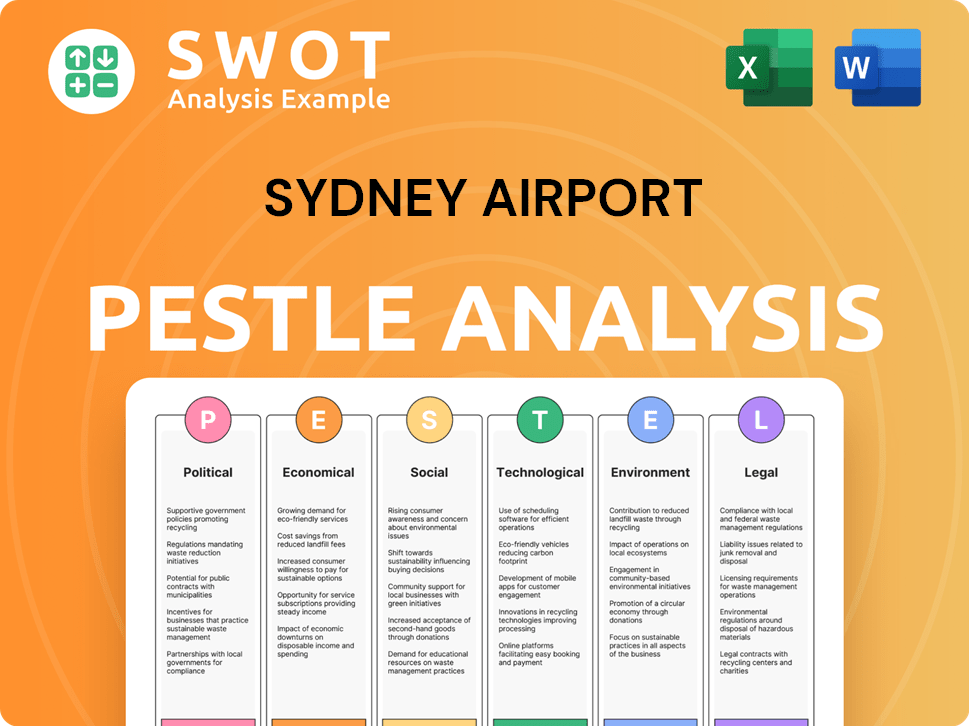
How Is Sydney Airport Positioned in the Market?
The brand positioning of Sydney Airport has undergone a significant transformation, shifting its identity from a mere transit hub to a multifaceted gateway representing the essence of Sydney. This strategic repositioning aims to establish the airport as a welcoming introduction to Australia and an extension of Sydney itself, focusing on creating memorable first impressions and lasting experiences.
The visual identity has been modernized with contemporary letterforms and a vibrant use of color, patterns, and photography to capture the spirit of Sydney. The emotive tone of voice aims to evoke the joy of travel and communicate the breadth of airport services. The goal is to create an emotional connection with travelers, highlighting the airport's offerings, including shopping, dining, and parking.
The focus on providing a premium and unique experience is central to Sydney Airport's brand strategy, exemplified by the launch of the SYD X luxury precinct. This positions the airport as a high-fashion destination, appealing to travelers seeking exclusive retail experiences. Advertising strategies target affluent and business-oriented travelers, with data showing that 71% of people find the airport experience special and distinct, and 77% of flyers respond to airport advertising, indicating a strong opportunity for luxury brands.
The airport's brand message has evolved from 'Sydney Airport' to 'Sydney's Airport,' emphasizing humanity, warmth, energy, and optimism. This shift reflects a desire to be seen as more than just a transit point, but as an integral part of the Sydney experience. This is a key aspect of the Owners & Shareholders of Sydney Airport strategy.
The visual identity incorporates bolder letterforms and a vibrant palette to reflect the city's essence. The tone of voice is designed to capture the joy of travel, highlighting services such as tax-free shopping and dining. This approach aims to create an emotional connection with travelers, enhancing their overall experience.
Sydney Airport targets affluent and business travelers by offering a premium and unique experience. The SYD X luxury precinct is a prime example of this strategy, positioning the airport as a high-fashion destination. This approach aims to attract travelers seeking exclusive retail experiences, enhancing the airport's appeal.
Brand consistency is maintained across all channels, from physical spaces to digital platforms. This approach ensures a cohesive brand experience. Recognition includes being crowned Oceania's Leading Airport in 2024 at the World Travel Awards, showcasing its strong brand perception.
The airport's brand strategy focuses on creating a premium and unique experience to attract high-value travelers. This includes luxury retail offerings and advertising campaigns. The airport's commitment to innovation and sustainability enhances its brand image.
- SYD X Luxury Precinct: A high-fashion destination within the airport.
- Advertising Effectiveness: 77% of flyers respond to airport advertising.
- Awards and Recognition: Oceania's Leading Airport in 2024 and the 2024 AAA Sustainability Award.
- Sustainability Focus: Reflects commitment to environmentally conscious consumers.
Sydney Airport Business Model Canvas
- Complete 9-Block Business Model Canvas
- Effortlessly Communicate Your Business Strategy
- Investor-Ready BMC Format
- 100% Editable and Customizable
- Clear and Structured Layout
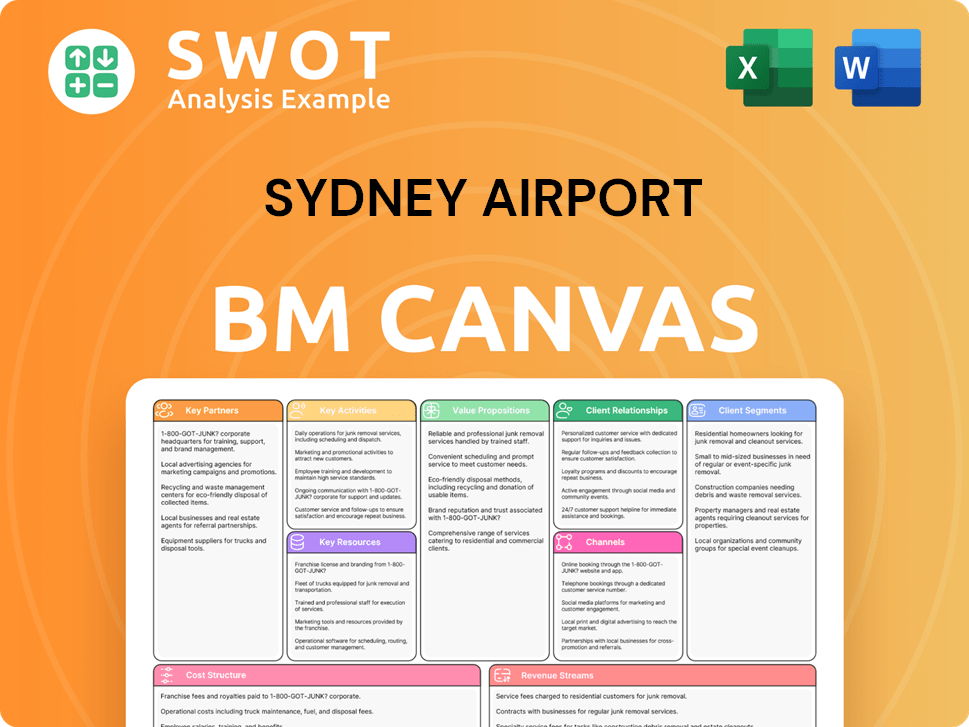
What Are Sydney Airport’s Most Notable Campaigns?
The sales and marketing strategies of Sydney Airport are crucial for driving passenger growth and increasing revenue. These strategies encompass a range of initiatives, including targeted advertising campaigns, digital marketing efforts, and brand positioning strategies. A strong focus on customer relationship management and stakeholder engagement also plays a vital role in the airport's success. This chapter highlights key campaigns that have significantly impacted the airport's performance.
Sydney Airport's commercial strategy is designed to enhance the passenger experience and maximize commercial revenue streams. This is achieved through a combination of retail sales strategy, promotional activities, and pricing strategies for airlines. The airport's ability to adapt to market changes and leverage data-driven insights is a key factor in its sustained success. Analyzing the target market and understanding passenger behavior are essential for effective marketing.
Effective marketing campaigns are essential for Sydney Airport's passenger growth. The focus on international passenger growth strategy and cargo sales strategy, along with the use of social media marketing, contributes to a robust sales and marketing plan. The following sections detail some of the most impactful campaigns.
The primary goal of the SYD X campaign, launched in 2023, was to establish Sydney Airport's luxury precinct as a premier high-fashion destination. This initiative aimed to create a unique retail experience, encouraging passengers to arrive early to explore the luxury brands. The campaign also sought to build a stronger brand presence for Sydney Airport, especially in anticipation of the Western Sydney Airport opening in 2026.
The SYD X campaign was built on the brand platform 'The Space Between,' highlighting the precinct as an unconventional retail destination. The 'X' branding was designed to capture the transient nature of travelers, encouraging personal interpretation. The brand identity was inspired by the airport's dynamic environment, presented through a high-fashion lens.
The SYD X launch utilized an integrated campaign across various platforms. This included Out-of-Home (OOH) advertising, print media, social media, influencer marketing, digital advertising, and performance marketing. A bespoke media strategy was implemented to drive awareness and influence passenger behavior.
The SYD X campaign achieved significant results, including over 12 million impressions on Meta, with over 300,000 engagements. Bespoke TikTok content co-created with influencers achieved a 12.2% click-through rate. The campaign also resulted in over 150,000 new website users and positive retail engagement, tracking to retail sales KPIs since its launch in February 2023.
The SYD X campaign featured collaborations with prominent figures. Australian entrepreneur Gab Waller served as a lead brand ambassador, alongside fashion influencer Tara Milk Tea, to create premium content and officially launch the precinct. These partnerships helped amplify the campaign's reach and impact.
Sydney Airport's commitment to sustainability is another key aspect of its brand strategy. The launch of Built Environment Sustainability (BES) Standards in 2024 demonstrates the airport's dedication to environmentally responsible practices. This commitment is aimed at attracting environmentally conscious travelers and potentially influencing airline partnerships.
The airport aims to achieve carbon neutrality by 2025 and reduce carbon emissions per passenger by 50% from 2010 levels by 2025. These goals are integral to the airport's sustainability strategy and contribute to its positive brand image. These efforts align with the growing global focus on environmental responsibility.
Sydney Airport regularly conducts multi-agency emergency management exercises to ensure preparedness. A simulated Boeing 737-800 crash scenario on October 24, 2024, involved 150 passengers and 200 personnel from 11 agencies. These exercises are crucial for maintaining passenger confidence and enhancing the airport's reputation.
The airport's commitment to safety and preparedness, as demonstrated by these exercises, indirectly contributes to passenger confidence and the overall brand reputation. These initiatives show the airport’s dedication to providing a secure and reliable travel experience. These practices reinforce the airport's standing in the industry.
Sydney Airport's success in sales and marketing stems from its integrated approach. The ability to work effectively from strategy to media buying, while optimizing creative for results, is a key factor. This strategic alignment ensures that the airport can effectively reach its target market and achieve its commercial objectives. To learn more about the airport's financial performance, read this article on Sydney Airport's financial strategies.
Sydney Airport Porter's Five Forces Analysis
- Covers All 5 Competitive Forces in Detail
- Structured for Consultants, Students, and Founders
- 100% Editable in Microsoft Word & Excel
- Instant Digital Download – Use Immediately
- Compatible with Mac & PC – Fully Unlocked
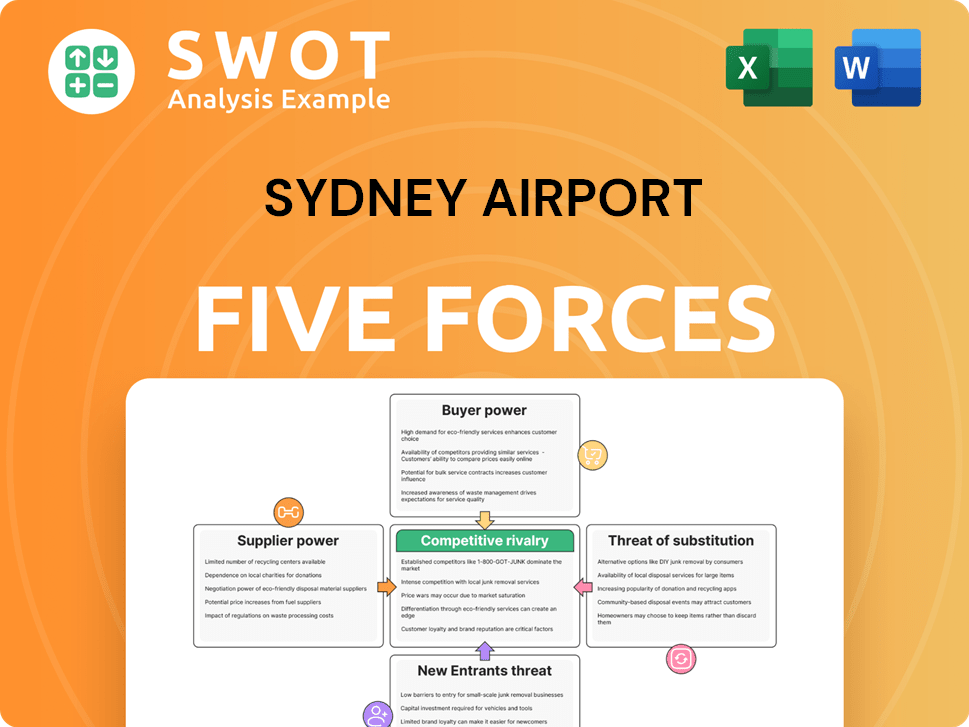
Related Blogs
- What are Mission Vision & Core Values of Sydney Airport Company?
- What is Competitive Landscape of Sydney Airport Company?
- What is Growth Strategy and Future Prospects of Sydney Airport Company?
- How Does Sydney Airport Company Work?
- What is Brief History of Sydney Airport Company?
- Who Owns Sydney Airport Company?
- What is Customer Demographics and Target Market of Sydney Airport Company?
Disclaimer
All information, articles, and product details provided on this website are for general informational and educational purposes only. We do not claim any ownership over, nor do we intend to infringe upon, any trademarks, copyrights, logos, brand names, or other intellectual property mentioned or depicted on this site. Such intellectual property remains the property of its respective owners, and any references here are made solely for identification or informational purposes, without implying any affiliation, endorsement, or partnership.
We make no representations or warranties, express or implied, regarding the accuracy, completeness, or suitability of any content or products presented. Nothing on this website should be construed as legal, tax, investment, financial, medical, or other professional advice. In addition, no part of this site—including articles or product references—constitutes a solicitation, recommendation, endorsement, advertisement, or offer to buy or sell any securities, franchises, or other financial instruments, particularly in jurisdictions where such activity would be unlawful.
All content is of a general nature and may not address the specific circumstances of any individual or entity. It is not a substitute for professional advice or services. Any actions you take based on the information provided here are strictly at your own risk. You accept full responsibility for any decisions or outcomes arising from your use of this website and agree to release us from any liability in connection with your use of, or reliance upon, the content or products found herein.